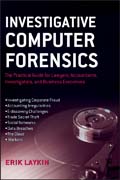
Investigative Computer Forensics: The Practical Guide for Lawyers, Accountants, Investigators, and Business Executives
Laykin, Erik
Accountants, CEOs, and other financial professionals need to understand how to leverage the newly emerging tools of computer forensics to protect assets, investigate fraud, and win the case. Investigative Computer Forensics takes the purely scientific aspects of classic computer forensics and marries them to the practical side of investigations and the pursuit of digital evidence in the course of litigation. It provides financial professionals with the necessary practical aids, case examples, and skills needed to leverage computer forensics during eDiscovery and investigations both domestically and abroad. INDICE: Foreword ix Preface xi Acknowledgments xv Author’s Note xvii Introduction Investigative Computer Forensics 1 Changes in Technology 1 Changes in the Role of the Investigator 2 What Is Computer Forensics? 4 Chapter 1 The Glue 7 The Relevancy of Truth 8 Foundations of Digital Evidence 9 Investigative Objectives 11 The Investigative Process 11 Trust 13 Privacy 14 Chapter 2 A Primer on Computers and Networks 17 The Mechanics of Electronically Stored Information 19 Optical Drives 25 The Server 27 The Router 30 Application Data 32 Metadata 35 Databases 37 E–mail Mechanics 41 The IP Address 43 Computer Time Artifacts 45 Social Media 45 Tablets 48 Cellular Telephones and Smartphones 50 Audio and Video 52 The Global Nervous System: Worldwide Data 54 Fundamentals of Network Traffic 58 The Firewall 59 Data– and Traffic–Gathering Applications 61 Dynamic Data Capture 63 The Cloud 65 International Data Security and Privacy Issues 67 Chapter 3 Computer Forensic Fundamentals 69 The Establishment of the Computer Forensic Laboratory 69 Evidence and Access Controls 73 The Forensic Workstation 79 Current Tools and Services 86 Building a Team and a Process 94 Computer Forensic Certifications 98 The Human Quotient 98 The Devil Is in the Details 124 Chapter 4 Investigative Fundamentals 127 The Investigative Mind–Set 127 Case Management 128 Fraud and Investigative Analysis 129 Information Sources and Records 130 Investigative Techniques 130 Surveillance and Interviewing 132 Trade Secret Theft and IP Investigations 133 Human Resources and Interpersonal Investigations 134 Reporting and Testifying 136 Chapter 5 The Underpinnings of Investigative Computer Forensics 139 Seizure and Examination of Digital Evidence 140 Data Classification and Records Management 140 Deleted Data 143 Backups and Systems Preservation 145 Computer Crime Analysis and Reconstruction 147 The Who, What, Where, How of Data 149 Contracts Agreements, Third Parties, and Other Headaches 154 Ethics and Management 155 Chapter 6 Tactical Objectives and Challenges in Investigative Computer Forensics 157 Preparing for the Attack 158 Early Case Assessment 159 Investigative Pacing, Timing, and Setting Expectations 160 Working with Multinational Teams 161 Collections of Electronic Data in the Cloud and in Social Media 162 Investigating Internet Service Provider Records 164 Bridging the Actual World with the Cyberworld 165 Packaging the Findings 165 Chapter 7 The Cyber–Firefighters 167 Incident Response Fundamentals 167 Data Breaches 170 Theft and Fraud 172 Systems Failures 172 Internal Investigations 173 The Real–Time Predicament 175 Building a Global Resource Network 175 Honeypots and Other Attractive Intel–Gathering Targets 176 Databases and Structured Data 178 Organized Crime in the Cyber–Underworld 178 The Cyber–Underworld in Various Regions 179 State–Sponsored Cybercrime 181 Identity Theft 182 Intellectual Property and Trade Secret Theft 183 Botnets, Malware, Trojans, and Phishing 184 Data Breach Vulnerabilities 185 Hackers and Their Environment 186 Chapter 8 E–Discovery Responsibilities 189 Data Identification 189 Electronic Discovery Reference Model 190 E–Discovery Stages 192 Common E–Discovery and Foreign Data Challenges 196 Tools, Services, and Technologies 199 Emerging E–Discovery Realities 202 European and Asian Observations 205 Digital Evidence in the Courtroom 207 Chapter 9 The Future 209 Privacy and the Data Ecosystem 209 Access Controls and the Evolution of Trust 211 Global Communications Systems in the Cloud 211 Nanotechnology and Cognitive Computing 212 Digital Demographics and the Emerging Global Citizen 212 Extra–National Investigative Networks and the Information Union 214 Zero Day Forensics 214 Concluding Thoughts 215 About the Author 217 Index 219
- ISBN: 978-0-470-93240-7
- Editorial: John Wiley & Sons
- Encuadernacion: Cartoné
- Páginas: 222
- Fecha Publicación: 17/05/2013
- Nº Volúmenes: 1
- Idioma: Inglés
